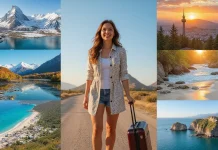Understanding the Benefits of Solo Travel
Embracing Independence and Empowerment
Solo travel is a unique opportunity to embrace independence and discover your personal capabilities. When traveling solo, you make every decision on your own, from where to eat to what activities to engage in. This independence can be incredibly empowering, boosting self-confidence and enhancing decision-making skills. You’ll learn to trust your instincts and rely on your judgment, leading to an overall sense of empowerment that can permeate other areas of your life.
Discovering Personal Interests and Preferences
Traveling alone allows you to dive deep into your interests and preferences without the influence of others. When you’re alone, there's no need to compromise on what you want to do. You can spend hours in an art gallery, hike a challenging trail, or lounge at the beach with a book—all at your leisure. This opportunity to truly engage in activities you love encourages self-discovery and a greater understanding of what truly makes you happy.
Choosing Your Destination
Consider Familiar and Safe Locations
When planning your first solo trip, it’s often best to choose a destination known for being safe and relatively easy to navigate. Places with a reputation for having friendly locals, good tourism infrastructure, and strong safety records can make for a reassuring backdrop as you adjust to traveling alone. Consider countries like Japan, New Zealand, or cities like Reykjavik and Copenhagen that offer great solo traveler support.
Think About Language and Cultural Barriers
Language and cultural barriers can be more challenging when traveling alone. If you're not ready for this aspect, consider choosing a destination where you speak the language or where English is widely spoken. This will make it easier for you to ask for directions, engage with locals, and resolve any problems you might encounter.
Align the Destination With Your Interests
Choose a destination that aligns with what you hope to gain from the experience. Are you looking for adventure, relaxation, or cultural immersion? Your destination should be a place where you can engage in activities and experiences that you're passionate about, whether that means hiking in national parks, relaxing on a beach, or exploring historic sites.
Budgeting for Your Solo Trip
Setting a Financial Plan
Crafting a budget is crucial for a solo trip. You will need to account for flights, accommodations, food, activities, and unexpected expenses. Research the cost of living in your chosen destination to create an approximate daily budget. Set aside some extra money for emergencies or spontaneous activities that might come your way.
Prioritizing Expenses
Identify what elements of the trip are most important to you and allocate your budget accordingly. Perhaps you want to splurge on a special experience like a hot air balloon ride, but are willing to stay in a hostel to save money. Prioritizing helps ensure that you have the resources to truly enjoy the aspects of your trip that matter most to you.
Finding Deals and Discounts
Take advantage of travel deals and discounts by booking elements of your trip in advance. Websites like Skyscanner, Kayak, and Booking.com offer competitive rates on flights and accommodations. Look for discounts on attraction tickets or group tours—even as a solo traveler, you can often join a group activity at a reduced rate.
Building an Itinerary
Balancing Structured Plans and Flexibility
While having a general plan is important, maintaining flexibility is crucial when traveling alone. Craft an itinerary that balances must-see places and activities with enough downtime and openness to explore spontaneously. Solo travel allows you to change plans without consulting anyone else, so embrace the chance to follow your curiosity.
Incorporating Must-See Sights
Research your destination to identify key landmarks, sights, and experiences that truly interest you. Whether it’s visiting historical sites, natural wonders, or cultural institutions, prioritize these in your itinerary so you don't miss out on these bucket-list experiences.
Including Rest and Relaxation
Traveling can be exhausting, especially when you’re doing it alone. It's important to incorporate periods of rest and relaxation into your itinerary. Set aside time for leisurely activities, such as reading in a park, enjoying a leisurely brunch, or taking an afternoon nap.
Accommodation Options for Solo Travelers
Pros and Cons of Hostels
Hostels are not only budget-friendly but also a great way to meet fellow travelers. Many offer communal areas perfect for socializing and participating in group activities. However, they may also lack privacy, so if that's a concern, look for hostels that offer private rooms or consider booking a single room.
Exploring Airbnb and Short-Term Rentals
Airbnb and similar platforms offer a range of accommodations from flats and homes to single rooms or shared spaces. Renting a space solo means having the privacy and comfort of a secured home environment. Choose accommodations with good reviews, clear communication from hosts, and strong safety ratings.
Budget-Friendly Hotels
Many budget hotels offer clean, private accommodations with amenities that solo travelers appreciate. Research hotel locations carefully to ensure proximity to the sites you're interested in, reducing travel time and expenses. Always check reviews by other solo travelers for insights on safety and hospitality.
Staying Safe on Your Solo Trip
Researching Local Customs and Behaviors
Understanding the cultural norms and customs of your destination is crucial to navigating social interactions and respecting local traditions. This awareness can help you avoid inadvertently offending locals and can also keep you safe by helping you blend in as a traveler.
Keeping Your Belongings Secure
Invest in quality, anti-theft backpacks or bags to keep your belongings safe while exploring. Always carry valuables close to your body and avoid displaying expensive items like jewelry and electronics. Consider using a money belt to keep your cash and important documents securely hidden.
Staying Connected
Before departing, ensure that your phone is equipped with a travel-friendly plan or get a local SIM card upon arrival for convenient data access. Share your itinerary with trusted friends or family members back home and keep them updated regularly on your movements and activities.
Navigating Transportation
Understanding Public Transport
Research the public transportation options available in your destination. Cities with developed infrastructure often have buses, trains, or subways that provide cost-effective and efficient travel. Familiarize yourself with transportation schedules, rules, and maps ahead of time to reduce stress.
Using Ride-Sharing Services
Apps like Uber and Lyft are available in many countries, offering a safe and convenient way to navigate unfamiliar cities. Ensure that your smartphone is ready to use these services by downloading the necessary apps, and familiarize yourself with local transportation norms regarding ride-sharing.
Considering Car Rentals
If you’re visiting a location where public transport is limited, renting a car might be a viable option. Make sure to familiarize yourself with local driving regulations, insurance requirements, and road signs. Having your own vehicle offers flexibility but also comes with added responsibilities and costs.
Eating Alone and Dining Out
Finding Solo-Friendly Restaurants
Look for cafes and restaurants that have communal dining areas or bars where solo travelers are common. These settings often make it easier to strike up conversations with locals or fellow travelers at neighboring tables.
Embracing Street Food and Cafés
Street food markets and local cafés present an exciting and budget-friendly way to sample regional cuisine. Often buzzing with activity, these places offer a more relaxed atmosphere for solo dining and provide a chance to observe everyday life in your surroundings.
Savoring the Experience
Dining alone can seem daunting, but it also offers a unique opportunity to focus on the culinary experience itself. Use this time to savor your meal, engage in people-watching, or do some reflective journaling about your travels so far.
Making Connections While Traveling Solo
Engaging in Group Activities
Joining group tours or activities can provide social interaction and facilitate meeting other travelers. Whether it's a guided city tour, a cooking class, or a group hike, such experiences can be rewarding both socially and in terms of sightseeing.
Staying in Hostels or Social Accommodations
As mentioned earlier, hostels can be social hubs for travelers. Participate in hostel-organized events, such as communal dinners or pub crawls, which are excellent settings for making new friends.
Using Social Apps for Travelers
Apps like Meetup, Couchsurfing events, or Bumble BFF facilitate meeting locals and travelers with similar interests. These platforms are designed to help solo travelers connect easily and safely with new acquaintances.
Cultivating Mindfulness and Reflection
Journaling Your Experiences
Bringing a travel journal allows you to record daily experiences, feelings, and reflections. This practice not only enhances your engagement with the travel experience but also provides a precious keepsake for revisiting memories of your solo trip.
Practicing Mindful Travel
Focus on being present and appreciative of your surroundings. Solo travel provides a unique chance for self-reflection and introspection. Engage with your senses—appreciate the sights, sounds, and smells around you to deeply connect with the places you visit.
Photography and Capturing Memories
Capturing your journey through photography is another form of reflection. Without the distractions of traveling with others, you can take time to find unique perspectives and subjects that truly resonate with you, creating a personal travel narrative.
Handling Challenges and Overcoming Obstacles
Embracing Uncertainty
Travel is unpredictable, and challenges may arise on your solo journey. Whether it's a missed train or language mix-up, maintaining a positive attitude and adaptable mindset can transform potential stressors into learning experiences.
Using Problem-Solving Skills
Solo travel hones your problem-solving skills as you’re required to independently navigate challenges in unfamiliar environments. View each obstacle as an opportunity to develop resilience and resourcefulness that can benefit other areas of your life.
Reaching Out for Help
Don't hesitate to reach out for help if needed. Be it locals, fellow travelers, or local authorities, most people are willing to assist. Don't view asking for help as a sign of weakness; it's often the quickest way to resolve an issue.
Maintaining Health and Wellness
Staying Active
Incorporate exercise into your travel routine by exploring on foot, going for runs, or participating in activities like yoga classes or hikes. Staying active helps you manage travel stress and keeps your energy levels high.
Eating Healthily
Experiencing new foods is a great aspect of travel, but try to maintain balance. Ensure you're eating plenty of fruits, vegetables, and staying hydrated. This will keep you feeling your best and ready to take on days of exploration.
Mental Health and Relaxation
Ensure to take breaks and give yourself time to relax. Practicing meditation or mindfulness sessions during your travels can help you stay grounded and mentally resilient. Recognize signs of homesickness or loneliness, and address them by contacting friends and family for support.
Ultimately, planning a solo trip involves balancing preparation and spontaneity, combining structured plans with the freedom to forge your own path, and embracing both solitude and social opportunities. With careful consideration and an open mind, your first solo journey can be a fulfilling and empowering adventure.
































